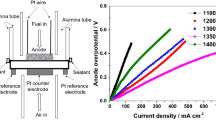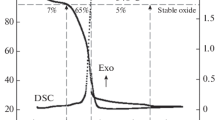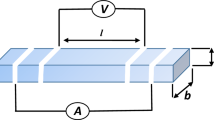Abstract
The lanthanum strontium titanate (LST) has to be calcined at significantly high temperature (above 1,300 °C) to obtain its pure perovskite structure when synthesized by conventional solid-state method, which is main reason for reducing active surface area. In this study, A-site deficient (La0.3Sr0.7)0.93TiO3 was synthesized by Pechini method. Although the prepared powders were calcined at 600 °C, the pure perovskite structure can be obtained without any secondary phase such as TiO2. Moreover, the porosity and surface area are 6 times and one order of magnitude higher in the LST powders synthesized by Pechini method than in the powders synthesized by solid-state method. Based on these results, the LST electrode (Pechini) leads to two times lower electrode resistance than the LST electrode (solid-state). Thus, the LST powders synthesized by Pechini can contributes to saving the energy needed for calcination process as well as increasing the porosity and active surface area, enhancing physical and electrochemical properties in SOFC anode.







Similar content being viewed by others
References
Steele BBH, Heinzel A (2001) Materials for fuel-cell technologies. Nature 414:345–354
Ziang SP, Chan SH (2004) A review of anode materials development in solid oxide fuel cells. J Mater Sci 39:4405–4439
Atkinson A, Barnett S, Gorte RJ, Irvine JTS, McEvoy AJ, Mogensen M, Singhal SC, Vohs J (2004) Advanced anodes for high-temperature fuel cells. Nat Mater 3:17–27
Tao S, Irvine JTS (2003) A redox-stable efficient anode for solid-oxide fuel cells. Nat Mater 2:320–323
Huang Y-H, Dass RI, Xing Z-L, Goodenough JB (2006) Double perovskites as anode materials for solid-oxide fuel cells. Science 312:254–257
Ruiz-Morales JC, Canales-Vázquez J, Savaniu C, Marrero-López D, Zhou W, Irvine JTS (2006) Disruption of extended defects in solid oxide fuel cell anodes for methane oxidation. Nature 439:568–571
Li X, Zhao H, Xu N, Zhou X, Zhang C, Chen N (2009) Electrical conduction behavior of La, Co co-doped SrTiO3 perovskite as anode material for solid oxide fuel cells. Int J Hydrogen Energy 34:6407–6414
Li X, Zhao H, Zhou X, Xu N, Xie Z, Chen N (2010) Electrical conductivity and structural stability of La-doped SrTiO3 with A-site deficiency as anode materials for solid oxide fuel cells. Int J Hydrogen Energy 35:7913–7918
Cho S, Fowler DE, Miller EC, Cronin JS, Poeppelmeier KR, Barnett SA (2013) Fe-substituted SrTiO3–δ–Ce0.9Gd0.1O2 composite anodes for solid oxide fuel cells. Energy Environ Sci 6:1850–1857
Cumming DJ, Kharton VV, Yaremchenko AA, Kovalevsky AV, Kilner JA (2011) Electrical properties and dimensional stability of Ce-doped SrTiO3−δ for solid oxide fuel cell applications. J Am Ceram Soc 94:2993–3000
Marina OA, Canfield NL, Stevenson JW (2002) Thermal electrical, and electrocatalytical properties of lanthanum-doped strontium titanate. Solid State Ion 149:21–28
Savaniu C-D, Irvine JTS (2009) Reduction studies and evaluation of surface modified A-site deficient La-doped SrTiO3 as anode material for IT-SOFCs. J Mater Chem 19:8119–8128
Tsvetkova Y, Kozhukharov V (2009) Synthesis and study of compositions of the La–Sr–Ti–O system for SOFCs anode development. Mater Des 30:206–209
Burnat D, Heel A, Holzer L, Kata D, Lis J, Graule T (2012) Synthesis and performance of A-site deficient lanthanum-doped strontium titanate by nanoparticle based spray pyrolysis. J Power Sources 201:26–36
Flandermeyer BF, Agarwal AK, Anderson HU, Nasrallah MM (1984) Oxidation-reduction behaviour of La-doped SrTiO3. J Mater Sci 19:2594–2598
Leite ER, Sousa CMG, Longo E, Varela JA (1995) Influence of polymerization on the synthesis of SrTiO3: part I. Characteristics of the polymeric precursors and their thermal decomposition. Ceram Int 21:143–152
Leite ER, Varela JA, Longo E, Paskocimas CA (1995) Influence of polymerization on the synthesis of SrTiO3: part II. Particle and agglomerate morphologies. Ceram Int 21:153–158
Fergus JW (2006) Oxide anode materials for solid oxide fuel cells. Solid State Ion 177:1529–1541
Acknowledgments
This work was supported by the National Research Foundation of Korea Grant funded by the Korean Government (MEST) (NRF-2009-C1AAA001-2009-0092926).
Author information
Authors and Affiliations
Corresponding author
Rights and permissions
About this article
Cite this article
Lee, J.G., Shul, Y.G. Physical and electrochemical properties of (La0.3Sr0.7)0.93TiO3–δ synthesized by Pechini method as an anode material for solid oxide fuel cells. J Sol-Gel Sci Technol 69, 148–154 (2014). https://doi.org/10.1007/s10971-013-3197-0
Received:
Accepted:
Published:
Issue Date:
DOI: https://doi.org/10.1007/s10971-013-3197-0




